
Mostly naughty


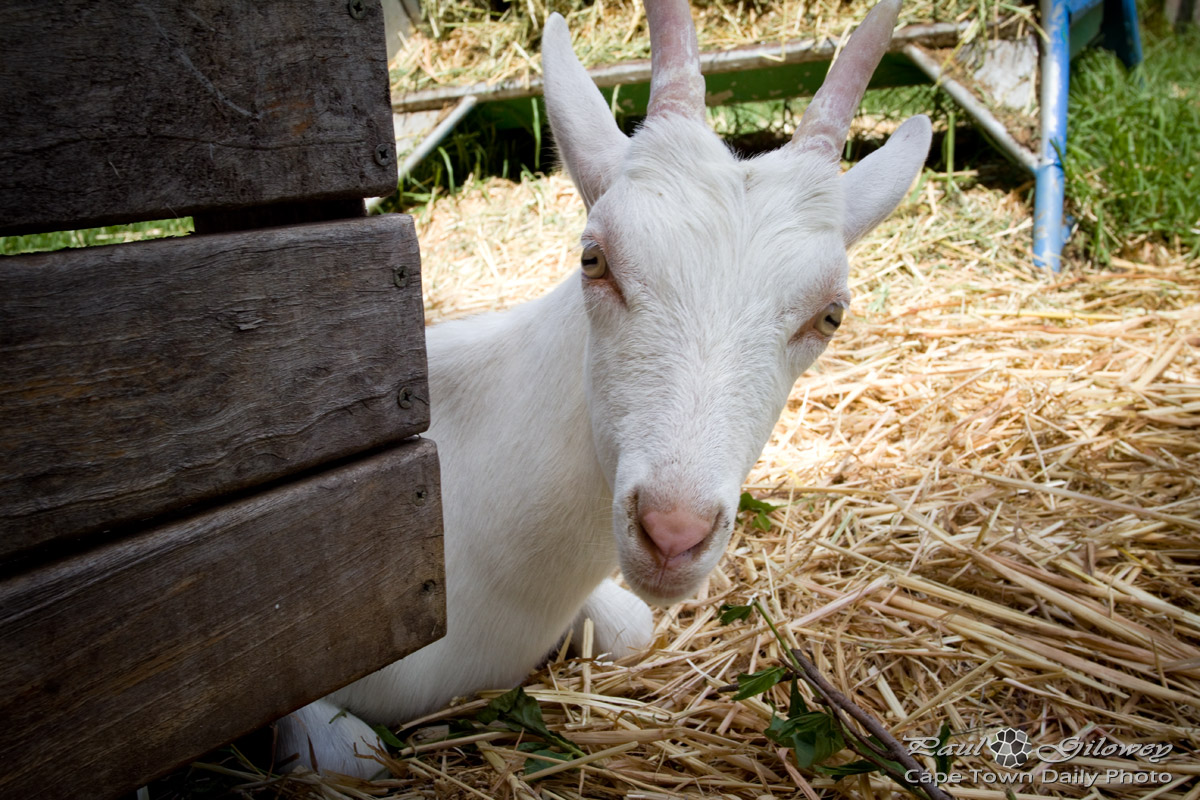

Joseph is a 10-year-old male cheetah who lives at Cheetah Outreach in Somerset West. Cheetah Outreach is a local conservation and education organisation that serves to save Cheetahs in the wild by educating the public.
Wild cheetahs are often killed by farmers who are forced to protect their livestock from these predators. Most of the funds raised go towards their Anatolian Shepherd Guard Dog programme which places the dogs on farms to ward off cheetahs, and in so doing dissuade farmers from hunting the cats.
If you'd like to get involved, or support Cheetah Outreach in some way, visit their website for a list of ways in which you can help.
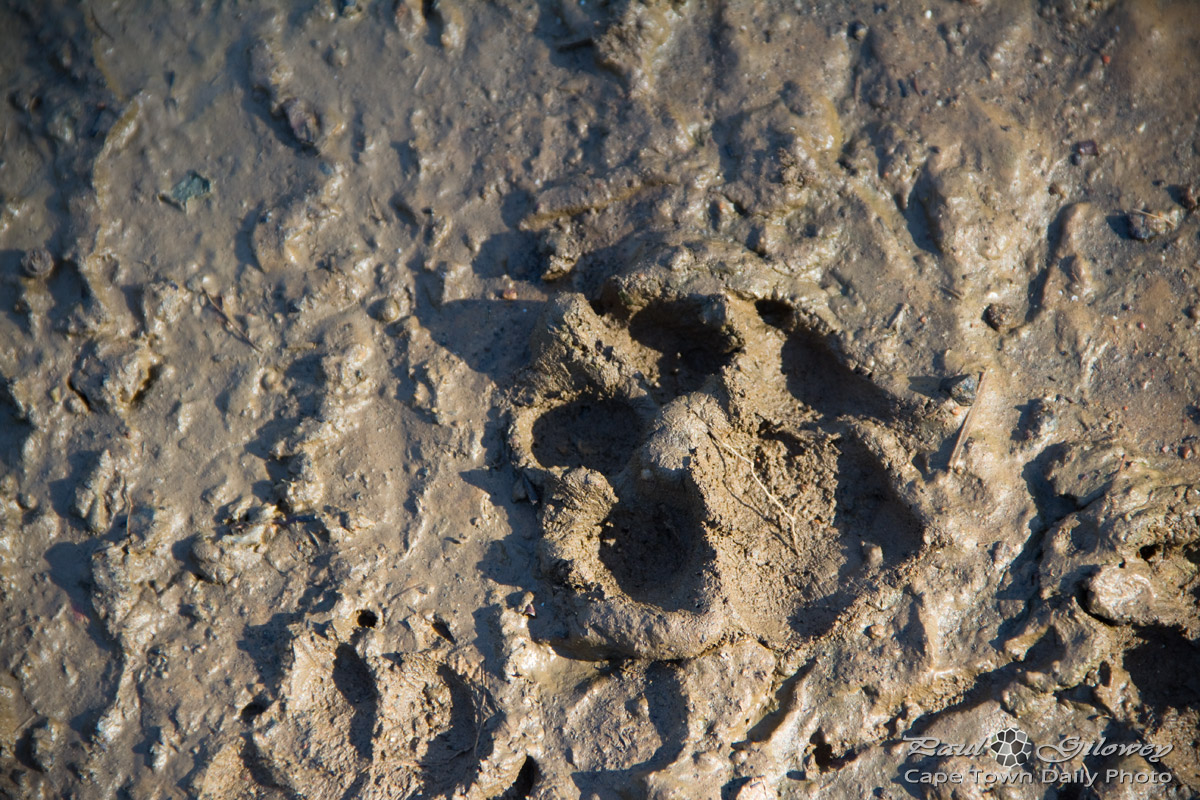
No, of course not - there's no way I'd have been walking on the same trail as a lion. This is probably a dog - and a domestic dog at that. I promise, you won't find big cats walking about on Table Mountain. You'll find leopards on some of our other mountains (like the Boland mountains), but certainly not near Cape Town itself. Fortunately. :)

From what I can tell, these are Dormer sheep, a cross between Dorset Horn rams and German Marinos. Together the two names make Dorset-Marinos, or Dormer for short.
The Dormer was specifically bred to be a mutton breed capable of adapting to cold and rainy winters, such as what we're currently experiencing in Cape Town! (It really is very wet and very chilly today, by the way!). Apparently the reason for having lambs at this time of the year is because of the abundance of food in winter, and the lack there of in summer.

This photo is of Kerry-Anne (also really excited to be playing with lambs) feeding one of the babies a strawberry milkshake. Nice hey?
For what it's worth, it wasn't actually a strawberry milkshake, it's a special formula that the farmer provides to feed the abandoned lambs.

Anyway, breeds aside, don't you love how, when you approach a herd, they gather closer to see what's happenin' and then when you raise your camera and walk closer they scurry away to the far corner of the field? Strange animals. :)
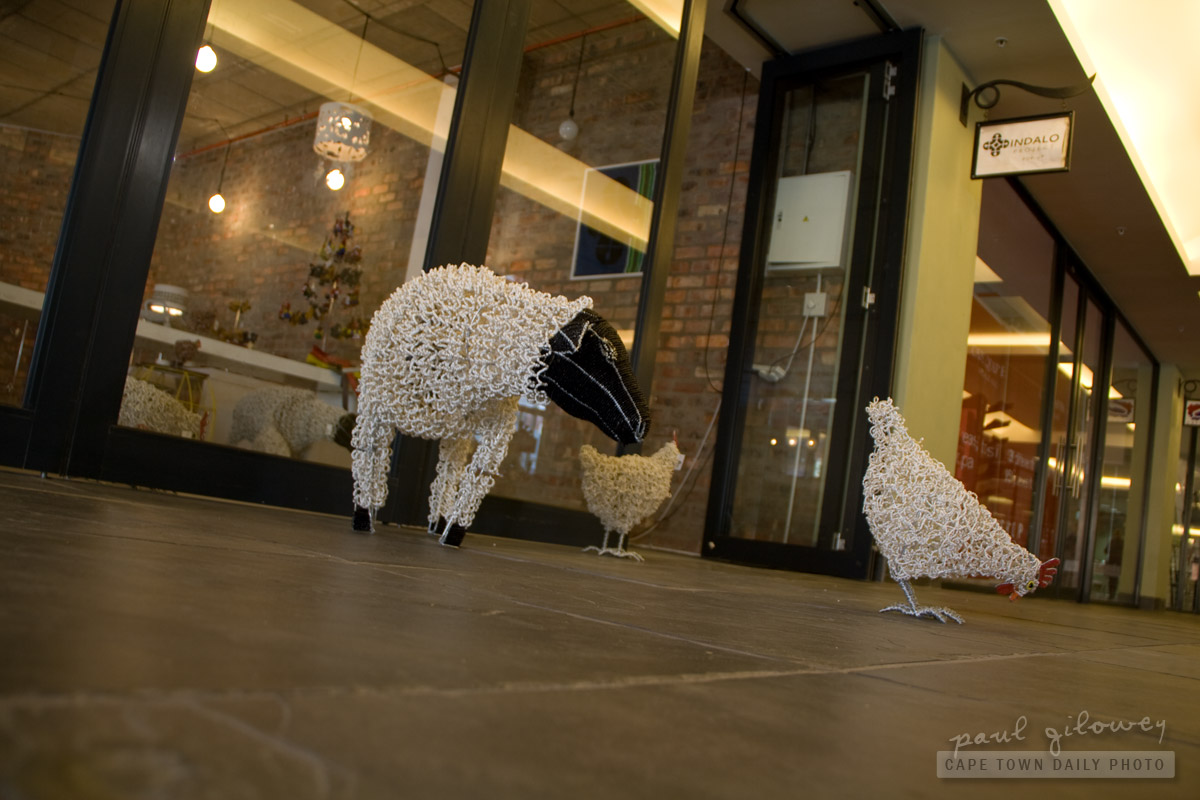
Besides for the shopping center, or places like African Trading Port at the V&A Waterfront, I've seen the people who make them selling these kind of beaded animals along the road.
Specifically, I've often seen them near the Tyger Valley shopping center and on the M3, at the Kirstenbosch traffic lights. That said, if you keep your eyes peeled you'll see many similar beaded animals for sale along the road all over the peninsula.

Click on the images below to see more zebra pics.
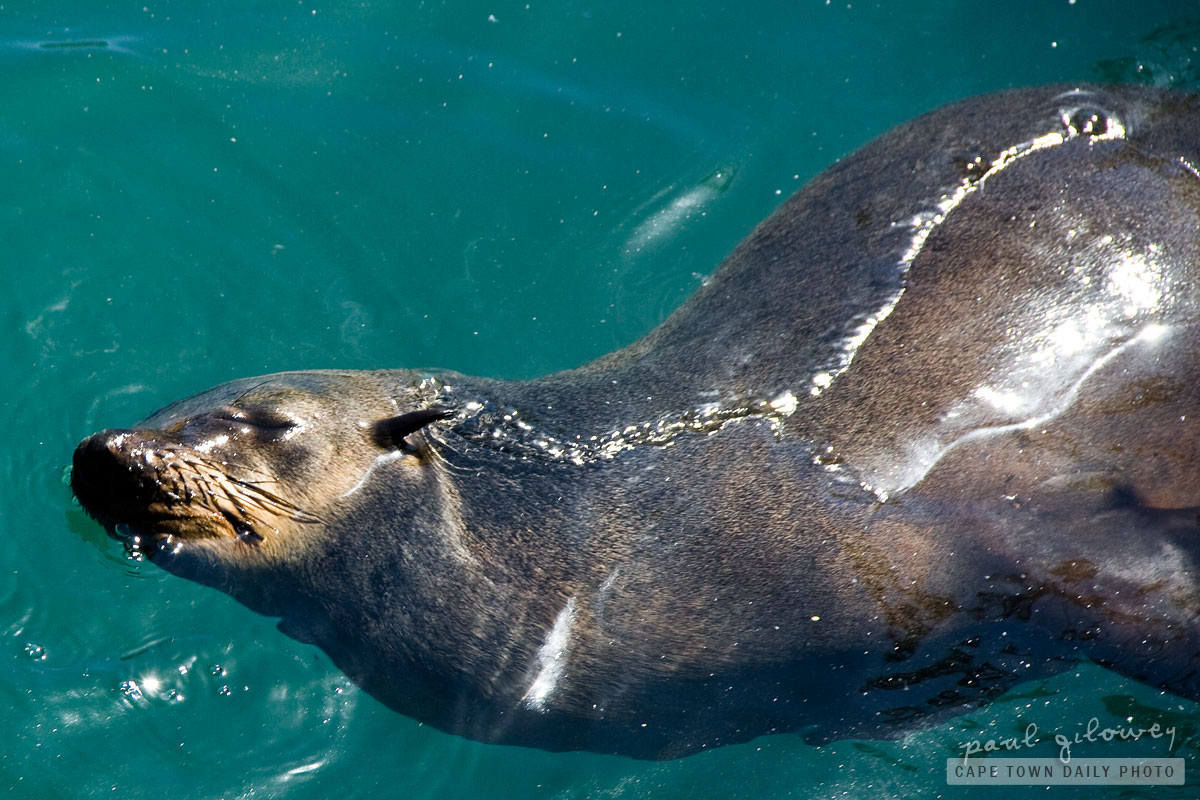
Each time that I see a seal up close I'm again amazed at how their looks and mannerisms resemble that of man's best friend - perhaps it's the brown-grey fur, or how they roll around in the sea, or perhaps the whiskers and pointy snout. Whatever it is, aren't they just awesome?
South Africa banned the hunting of seals 21 years ago, but one of our close neighbours, Namibia, still allows these seals to be hunted and clubbed to death. The slain seal cub's fur is sold exclusively to a (much hated) man by the name of Hatem Yavuz, who in turn sells the fur to the fashion industry.
Doesn't that just suck? :-(

If you're a local, or a visiting tourist, please support our roadside vendors. In a country with a high person to job ratio it's one of the few ways that these guys can make money. Thanks! :)
Visit our other site, the Red Balloon Craft Junction for crafter listings, information about craft markets, and several other bits and pieces that you may find interesting!

Would you call this a flock of birds or a small family of siblings? I haven't quite decided, but they do kinda look like a quintet of sisters. The five of them appeared to potter about the lawn in a small cluster, attacking worms 'n bugs with great enthusiasm. A second before I took this photo a loud sound startled what I presume to be the oldest sister, causing her to take flight towards shelter, with her four sisters immediately following suit.
My untrained bird-watching eye identifies these birds as being of the Cape Sparrow variety, often referred to by the Afrikaans name, Mossie (which sounds something like "maw-see"). Assuming my bird-watching eye hasn't let me down, then these are five females, as the males, you'll find, have black feathers covering most of their head.
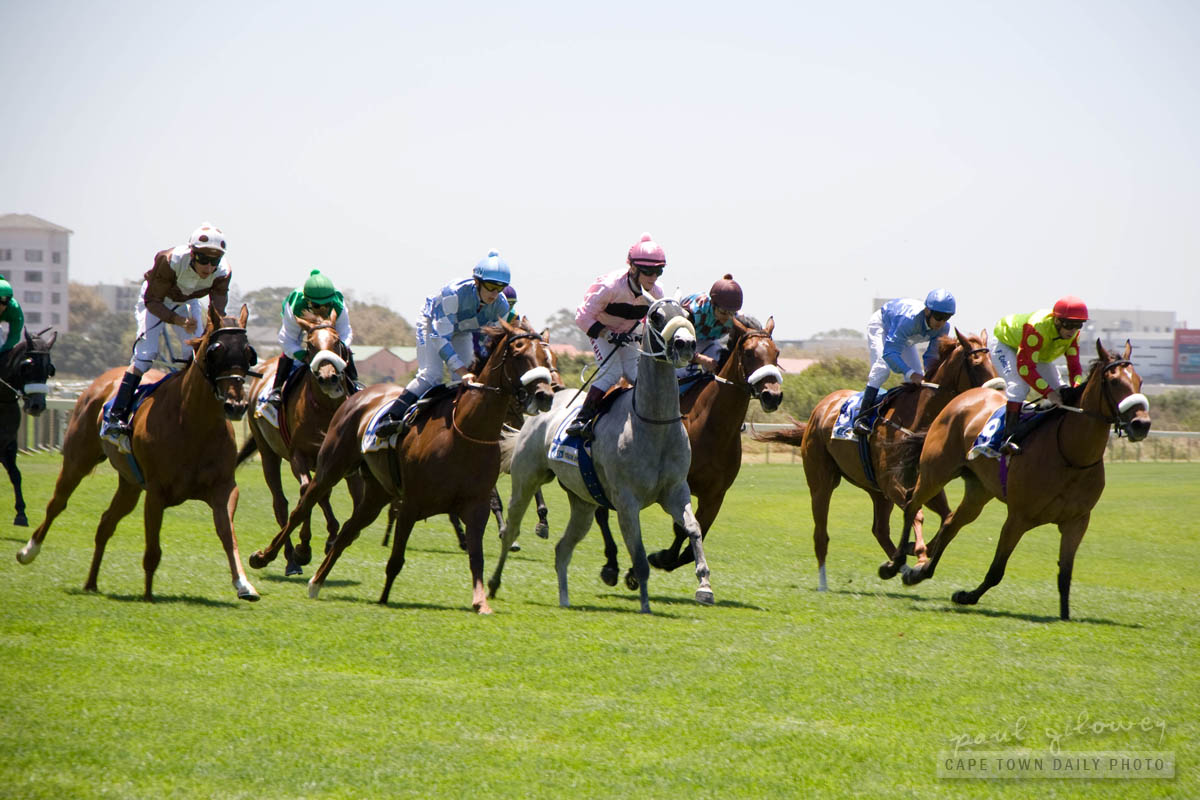
Even though J&B have been sponsoring the J&B Met for only 34 years, as mentioned in a previous post the event's history goes back to the 1800s, when the Cape was still under British rule. Each year sees dozens of horse racing events taking place at tracks like Kenilworth, Royal Ascot and Durbanville, but this, the J&B Met, is the premier of all races - the crème de la crème!
Despite being aware of horse racing for many years, I've never really known how betting takes place, and I've never really understood the different types of betting. Included with our ticket for the day was a small betting voucher and a guide that explained the three most popular bet types:
Unfortunately for us, we didn't win any money this time around. But after the main race at 16h30 there seemed to be several very happy faces in our vicinity, which I took to mean that a lucky (or clever) few actually did win some money. :)
Click here to see an album with a few more photos of the horses and the track. And check back during the week - we'll be posting another album or two with photos of the celebrities, the food, and the stylish outfits we spotted in the J&B hospitality marquee.
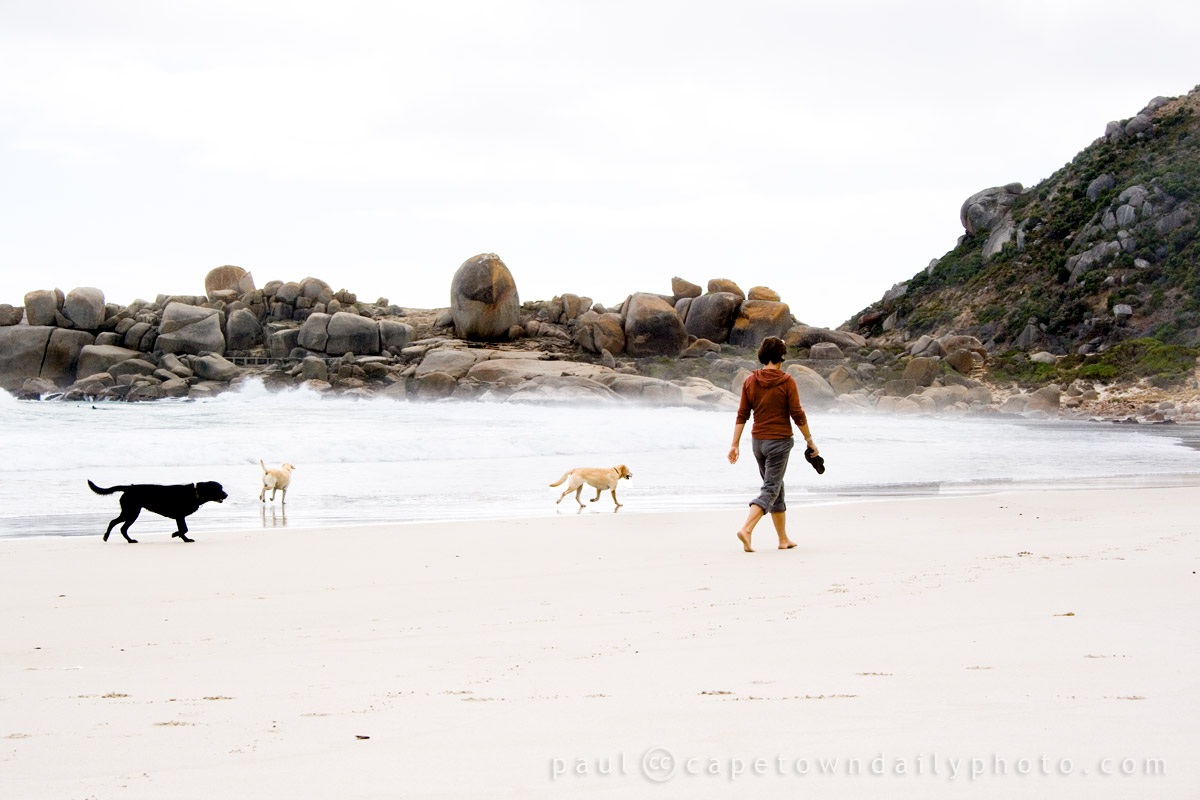
I never paid attention to the sign that indicates the restrictions, but I presume that walking dogs is allowed because it seems to me that the beach is the only place where residents of the little suburb would be able to do so. Llandudno is built on the slopes of the mountain that lead down to the water's edge, so the chance of finding a nice open field on which your dogs could run is pretty much nil. :)

I came across this spear-fisherman and his brother at Scarborough busy trying to sell the last of the ten yellowtail that they'd speared close to Cape Point. Their price? R100 per fish! Isn't that just a crazy price? I'm not 100% sure what yellowtail costs in supermarkets, but I'm sure that it's in excess of R50 per kilogram, making this buy an absolute bargain.
The only reason I didn't buy one was that I'd have had to transport it 65 kilometres home in the back of my car, without a proper fish bag to contain the fishy aroma. :)
I wrote an article a while back about recreational fishing around the Cape Peninsula, so check that out for details on where to purchase permits - they're really cheap. I had a quick look for limits with respect to quotas for line fish like yellowtail and it appears as though it's currently limited to ten per person. So, if you're lucky enough to bag a whole lot of yellowtail, make sure that you only take ten - the fines are pretty hefty.

I'm not much of a jazz fan, but I have to admit that the AquaJazz show at the V&A Waterfront's Aqua Festival was pretty good. I took this photo to the right of the stage, a little while before the show - as the light was fading. Isn't the yacht basin just beautiful? It must be awesome to own an apartment that's part of such a beautiful view... even more, it must be awesome to own that huge yacht in the middle of the photo!
The seals that you see on the jetty are interesting creatures. For each show that I've attended they've sat on the jetty talking to each other in their dog-like grunts and barks. The jetty connects to a landing that the performers use to walk to the stage, and often the stage security guys have to spray water on the seals to encourage them to move off the landing so that the performers can make their way to the stage without being pushed into the water by a huge lumbering seal.
It's really entertaining to watch the little dance between the seals and the security people. :D
Edit: I've just published an album for the AquaJazz show here.
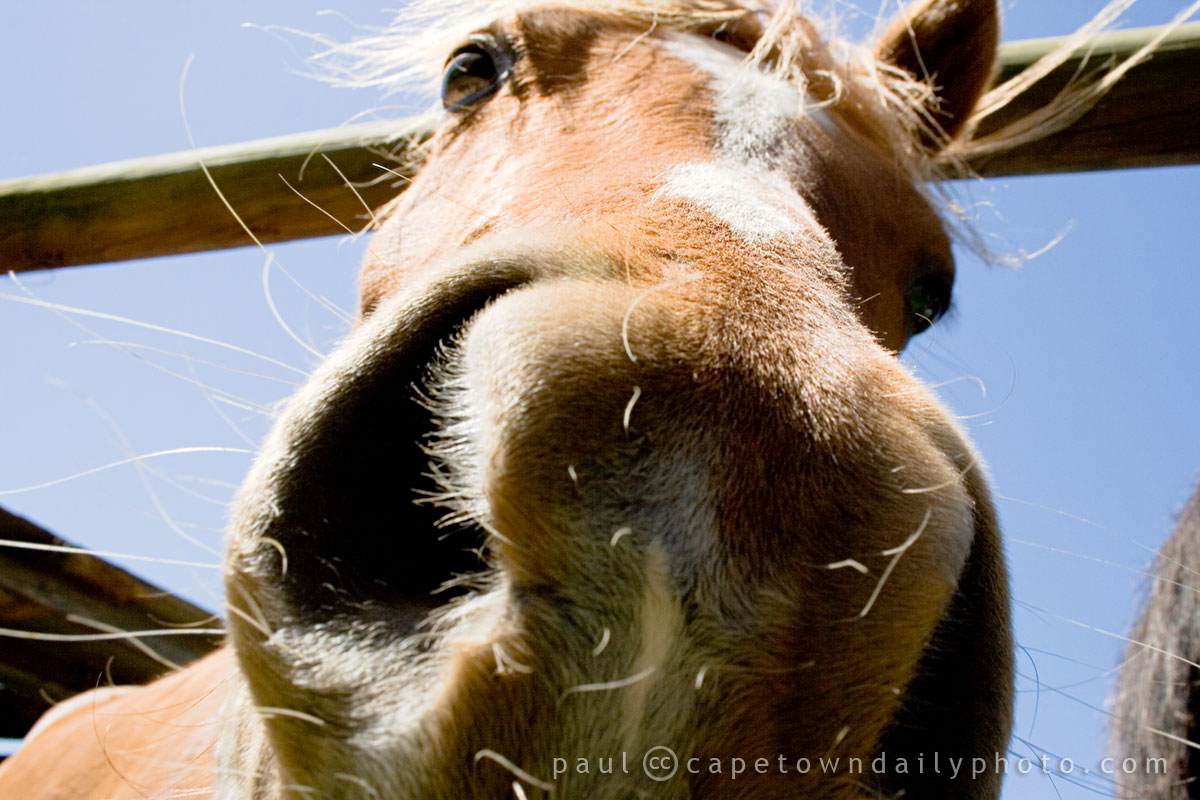
Can you see the way Big Mike was trying to stare me down?
The first (and only) time that I risked climbing on a horse, the beast in question turned out to be an obstinate animal with a mind of its own, refusing to listen to my gentle (and later, extremely firm) tugs on the reigns. My animal dragged its hooves, keeping a good 50 metres from the rest of the group, and when I dug in my heels it ignored me like a cat being told not to jump over a wall.
If you have more luck than I do with horses (or cats) then check out Horse Trail Safaris - it was some years back, but I think they were the ones who took us on that beach ride in Hermanus.

We stopped over at the Durbanville Wine Valley Season of Sauvignon 2009 festival on Saturday. Although Jimbo here wasn't part of the festival, he kept a keen eye on the proceedings while munching on ground-greens. I plucked this juicy, yummy-looking weed from my side of the fence and handed it over.
After only a few nibbles, Jimbo's connoisseur's tongue rejected my offering, and he instead demanded a couple of life's simple pleasures: nose-strokes and head-pats. Horses are so easy to please.
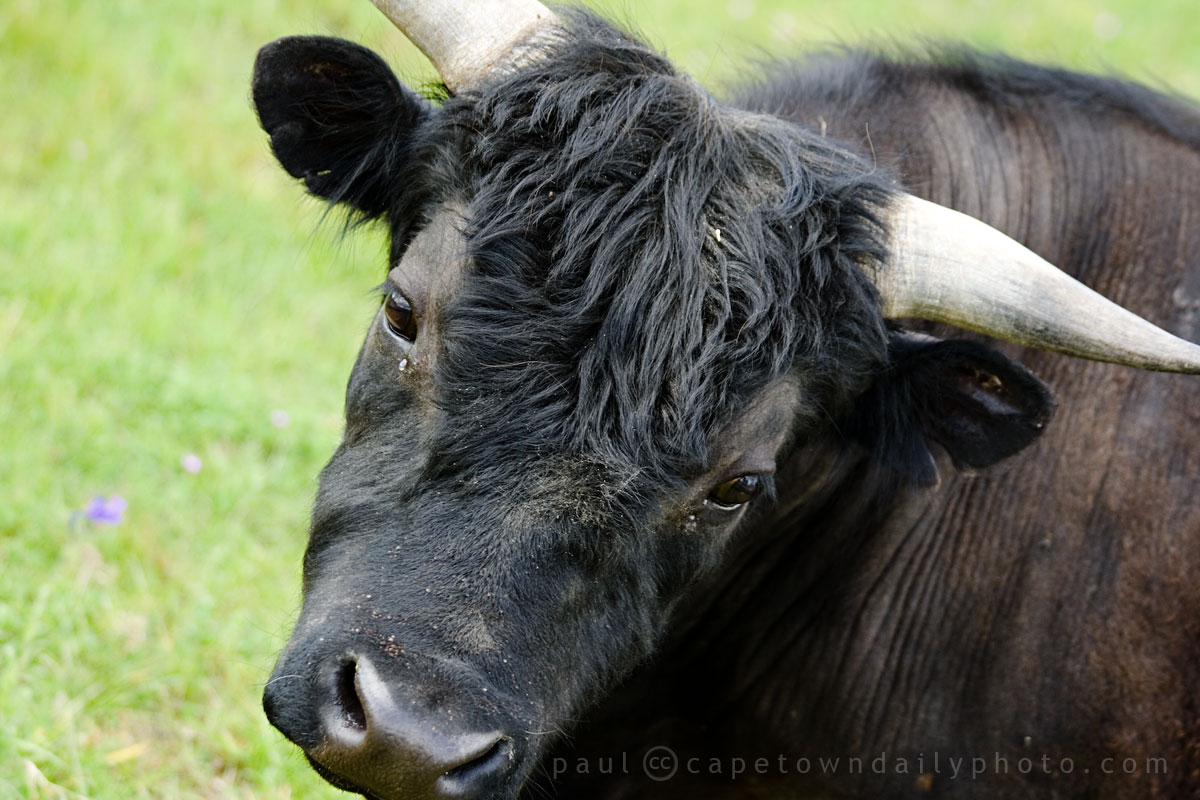
We took an afternoon drive out the back of a slightly-away-from-civilisation suburb called Joostenbergvlakte, so in the next few days we'll bring you a few gems that we discovered in the area.
Joostenbergvlakte (pronounced something like "Yooah-sten-berg-fluck-tuh") is a suburb of smallholdings, inhabited by people who like to farm on a small scale, or who need a lot of space for their horses or some kind of business. People sometimes even buy these smallholdings simply because they like a LOT of space around them, as opposed to the relatively little space that suburbs closer to the city afford their residents.
Some people love it and dream of owning a tiny farm, but not I - and even more so not Kerry-Anne. :)
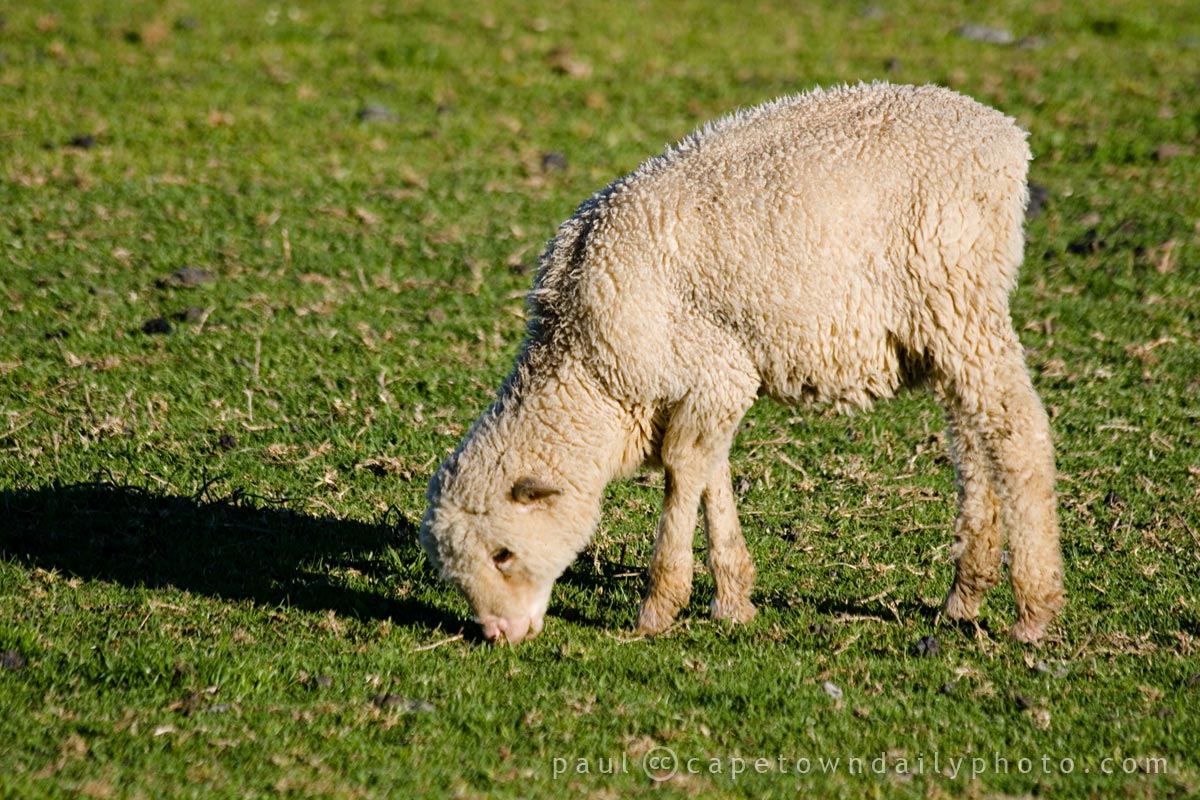
Kerry-Anne loves lambs. What more is there to say, really?
When on honeymoon a few *cough* years ago we stayed over at a remote self-catering place called Red Stone Hills. It's out on a farm and really (REALLY) rustic. We took a walk around the farm one day and Kerry-Anne decided to get into the pen with the sheep... who promptly surrounded her. Not so cute anymore were those killer sheep! It was amusing to watch her raise her hands in the air and squeal for help. Boys are so mean - apparently. :D
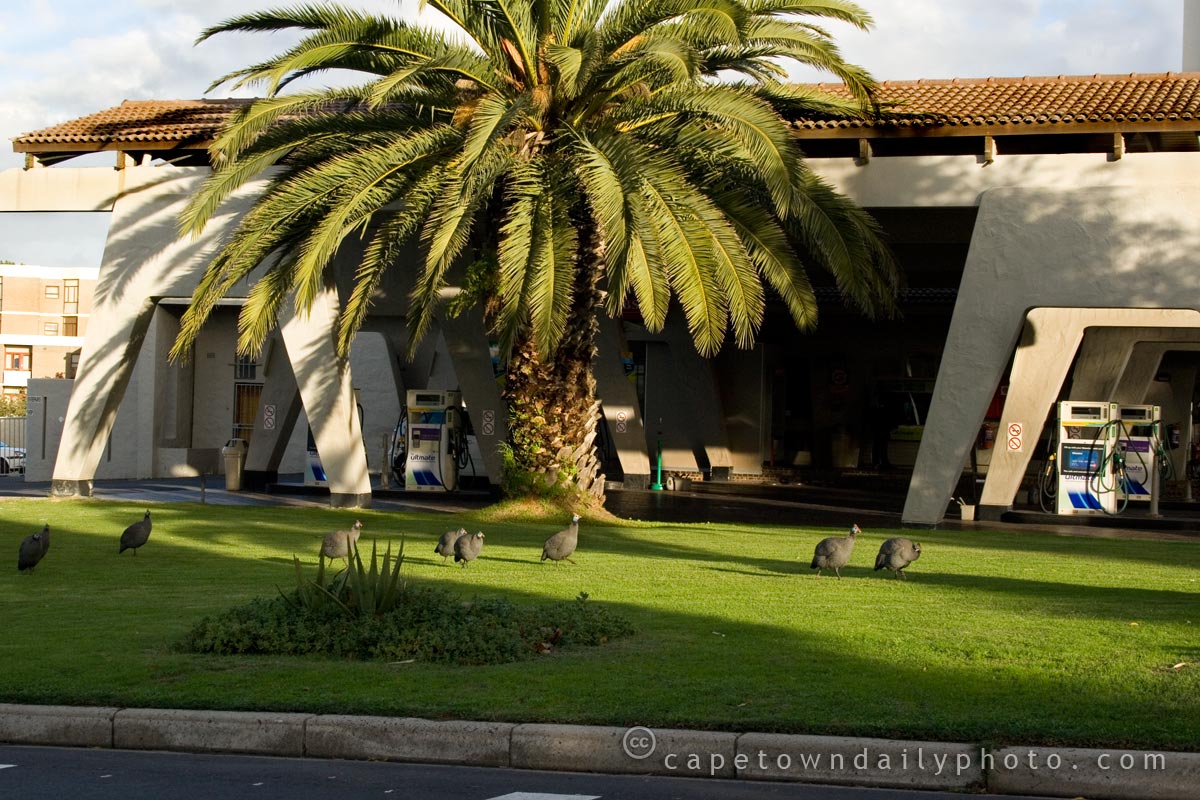
Let's stick with the petrol station theme for one more post, shall we?
I've never been much into ornithology - I don't have a particularly lengthy attention span, and let's face it, for the most part birds just aren't that exciting. Guinea fowl are different, though. While I find the average sunbird or robin pretty and all, a flock of guinea fowl actually has the capacity to entertain me.
They always look so purposeful. I mean, take this lot for instance. They're going to the petrol station, aren't they? Not wandering about aimlessly on a lawn. They have "things to do". Also, they always appear to be having meetings. There's something bizarrely anthropomorphic about this species.
I once spent ages watching a big group of them taking turns to jump off a concrete water reservoir. (Yes, I said "jump". Guinea fowl don't fly unless they absolutely have to - say, to get up onto a water reservoir.) They formed an orderly queue and slowly jumped off one by one. And I could have sworn that the braver ones, who were already on the ground, were teasing the scaredy-birds about being too afraid to jump.
Fortunately for me, we have one or two large flocks of guinea fowl in our neighbourhood, and they seem to make their way up the street systematically over a period of weeks, stopping in at a different garden each day. When they're visiting our garden, I usually call the cats and then all three of us spend a few minutes watching the Enormous Birdies through the window.
It's the small things... ;-)
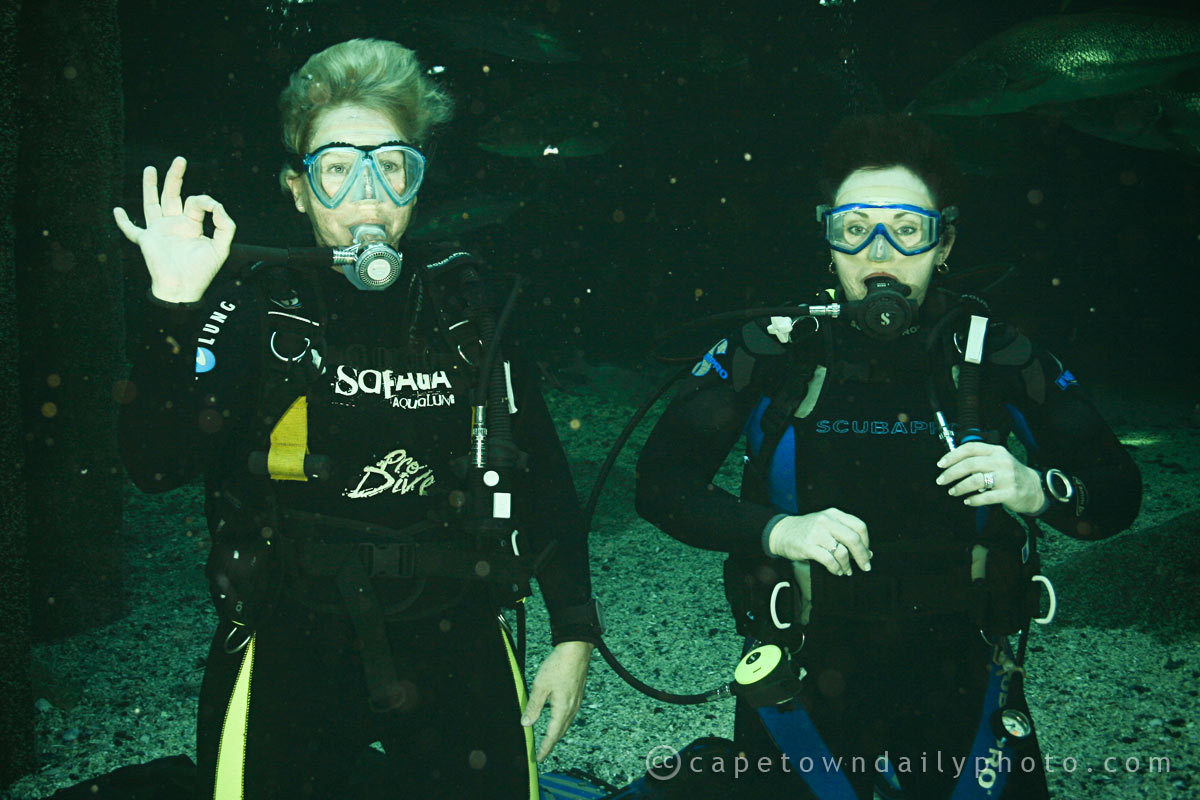
The words cancer and shark evoke a common reaction in many people. Both induce a sense of fear. Lung cancer is one of the most difficult forms of the illness to treat, but, however dire the situation, it would seem as though it is treatable.
The two ladies in the photo, Leni White and Teresa Renier, are in fact lung cancer survivors! What makes them special is that even though most doctors would strongly caution against SCUBA diving after beating lung cancer - these two ladies still dive, with no apparent ill effects.
The two ladies, having beaten cancer, took on the other fearsome challenge in support of Lung Cancer Awareness Month, when they dropped themselves into a tank of sharks at Cape Town's Two Oceans Aquarium. Although they were understandably a little nervous, all went well and they left the tank heroes in their own right. Read more about their story here, in BizCommunity's medical news section.
Disclaimer: Kerry-Anne and I are not in the medical field and don't suggest that you should do anything without consulting your physician first. If you've survived lung cancer and would like to dive, please consult your physician and, as Leni and Teresa do, understand the risks.
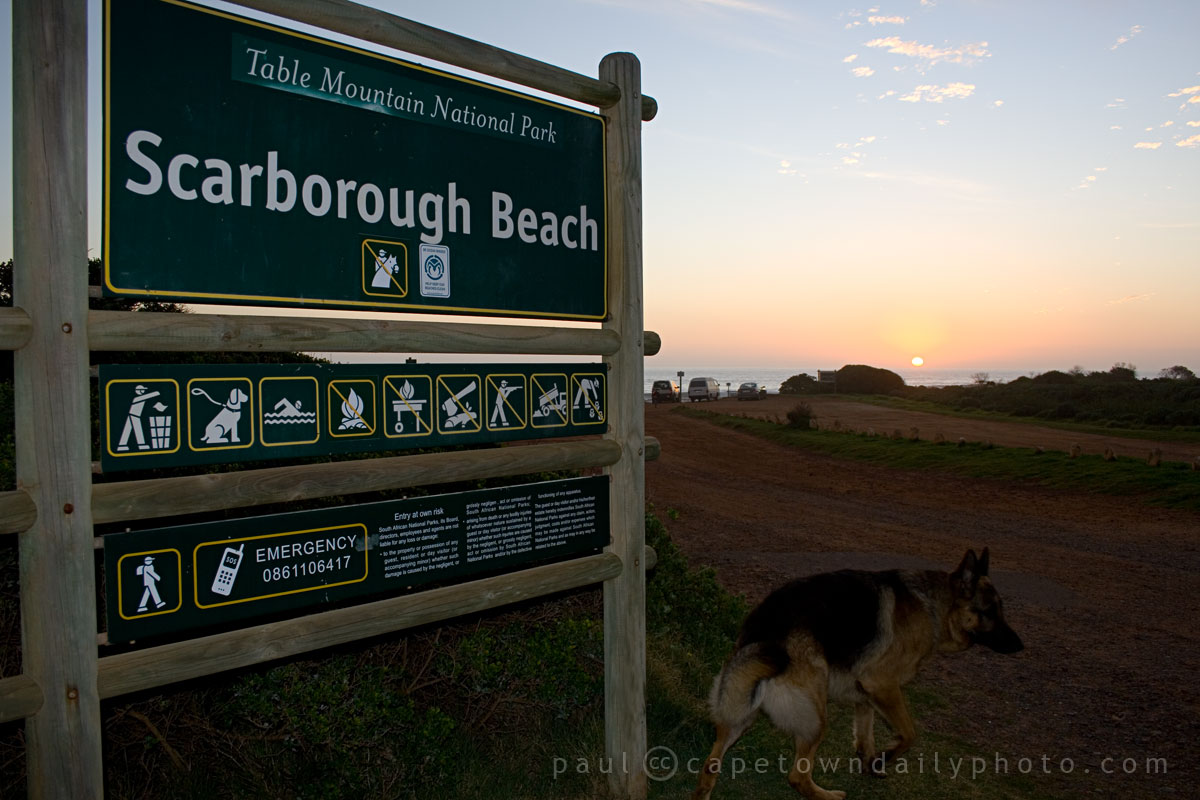
In the previous posts Kerry-Anne told you about a seaside village where a friend of ours owns a beautiful wooden house. Some of you guessed correctly that the little village is Scarborough - well done! This quiet suburb is to the west of Simon's Town, just on the other side of Cape Point. Find it here on the Google Map.
I browsed the web for the word Scarborough and found that this village is not by any means the only place bearing the name. It would seem as though our British friends have indeed been busy - according to Wikipedia there are a plethora of place-names (and other names) containing the word Scarborough, all around the world.
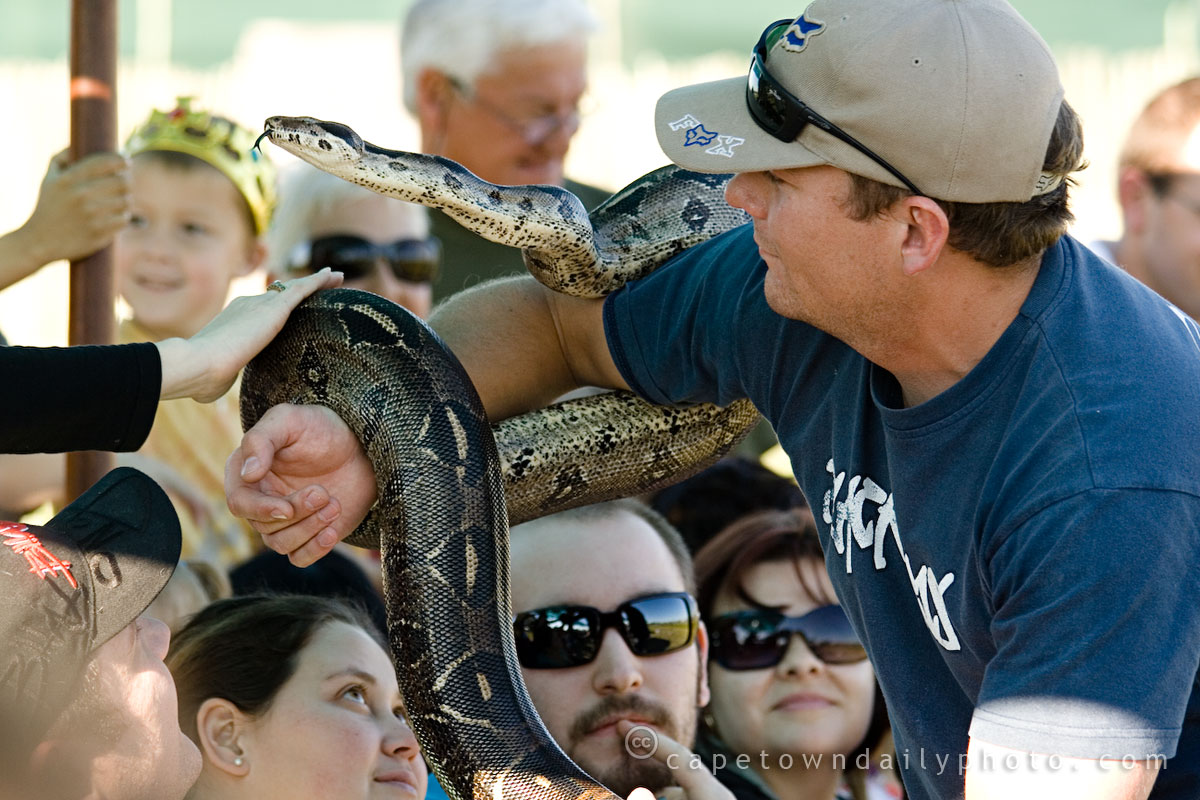
Apart from the album that I've uploaded, this is the last of the photos that I'll post from our visit to The Giraffe House. Boa Constrictors aren't native to Africa, but I thought that I'd post this photo because the snake show/educational was so interesting. I'm not a parent, but what was nice was that the snake handler in the photo engaged with and invited kids forward to touch and hold snakes - yup, even this large Boa Constrictor.
One of the interesting things that I learned was that Boa Constrictors are often kept as pets and each year several owners are killed by their friendly slithery snakes. Boas are classified as constrictors, and contrary to what you may think, they don't actually crush their prey, they suffocate it. Each time the animal (or... erm... human) breathes out, the reptile tightens its grip so that the prey is unable to fill its lungs properly. Eventually the victim is unable to catch a breath and suffocates. So... DON'T BREATHE OUT! :)
One of the other interesting things that we were taught is that if a snake is coloured with red, yellow and black, the rule of thumb is that if the red scales touch the black scales then the snake isn't poisonous [*see edit below], but if red touches yellow... you should probably back off. The handy rhyme goes:
"Red touching black - poison lack; red touching yellow will kill a fellow."
EDIT: Please see my the comment below which corrects what I understood the handler was meant by red/black and red/yellow.
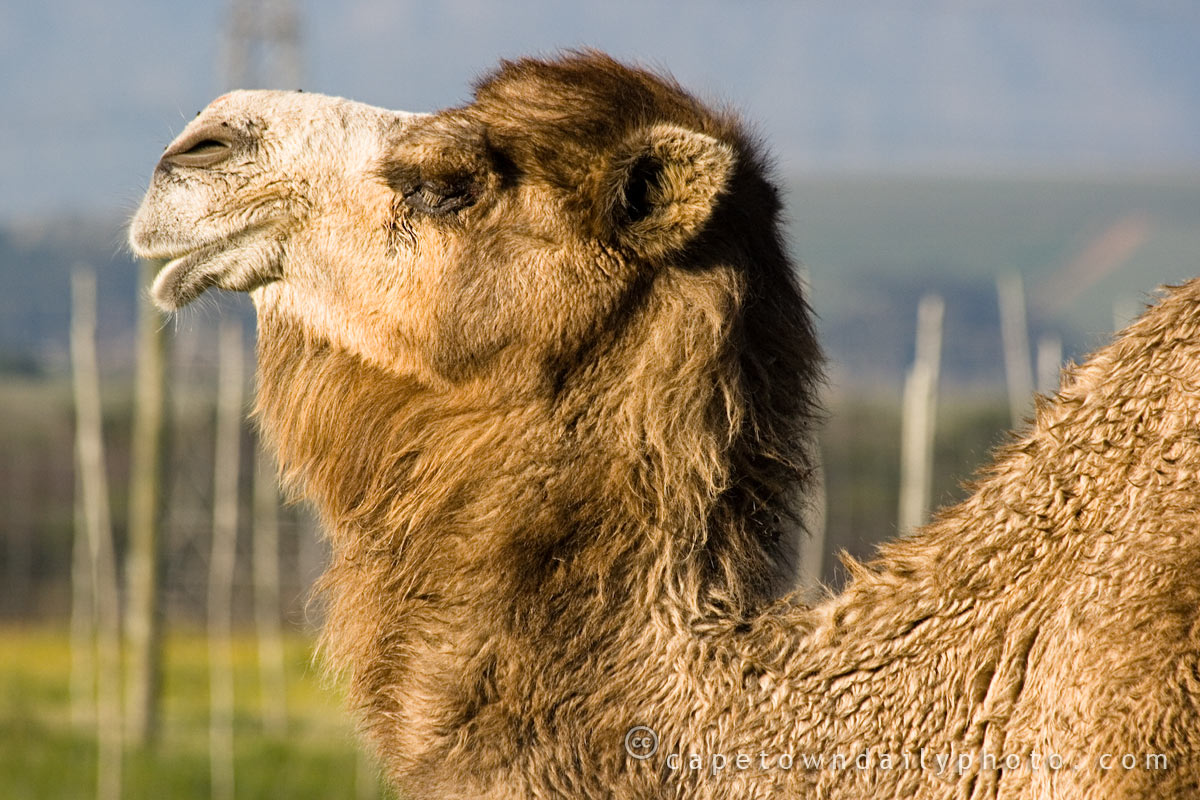
Pete (that's our name for the camel we found at The Giraffe House) is a Bactrian camel - meaning that this fellow is of the two-humped variety.
The Bactrian Camel is apparently one of only two species of camel, the other being the Arabian, or Dromedary, camel. What I found interesting is that there are only very few camels in the world that are not domesticated. The weirdest thing of all is that it seems as though the camel is the only land mammel able to drink salt water without suffering ill effects!
One of the fun things you can do in Cape Town is to take a ride on a camel: Imhoff Farm offers short rides around the farm as well as a 2-hour-long "Bush Ride", which I hear is loads of fun.
If you've ever taken a ride on the Imhoff Farm camels, please leave a comment and tell us what your experience was like (as well as any tips that one may find useful on a 2-hour-long camel ride!). The only camel ride Kerry-Anne and I have taken was a short one on an Arabian camel while on honeymoon many years ago.
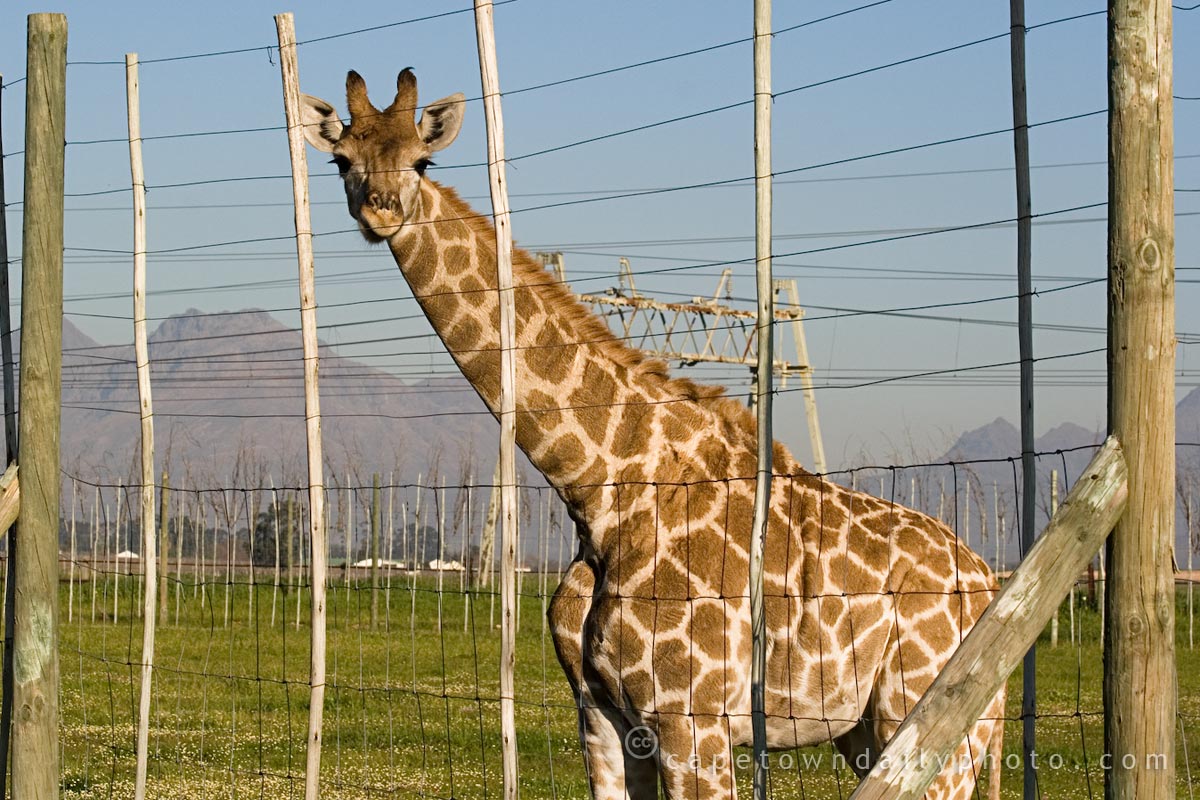
There we were, at The Giraffe House, and unbeknown to us we had a famous actor in our midst. According to iAfrica, baby Gerry is a star in the soon-to-be-released movie Free Willy 4. At the time I wondered why she immediately rushed over to us when I pulled my camera from my bag! To think that she's only just over a year old and already a star! Kids grow up so fast.
On a more serious note, it's worthwhile taking your kids to see the few animals at The Giraffe House, especially since they have "animal encounters" each day at 11h00, 13h00 and 15h00, showing snakes, birds, tortoises, a speedy caracal (called Felix) and the perhaps the coolest of all, Gerry’s 16-litre bottle-feeding.
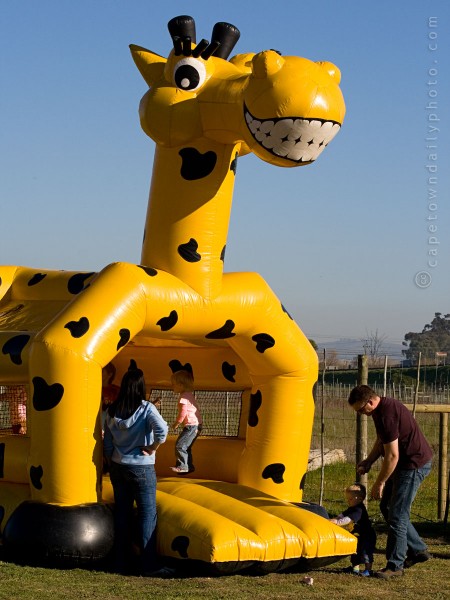
Not only does The Giraffe House have this bouncy plastic giraffe (don't you love his smile? :) ), but they have a real one too! Right here in Cape Town, just down the road from Stellenbosch! I did catch a few (well, actually plenty of) shots of the tall and timid animal, but that I'll show you in Monday's post.
We've been meaning to visit The Giraffe House for some time now, so when we were given the choice of going to our godchild's 6th birthday party HERE or a "boring adult cake-and-tea"... erm... there was no contest. Definitely, The Giraffe House! The cool thing about the place was that they don't only have a giraffe, but also an assortment of other animals, some of which I'll show you on Tuesday and perhaps Wednesday.
Thanks, Ethan, for having a birthday and convincing your mom to take us all to The Giraffe House!
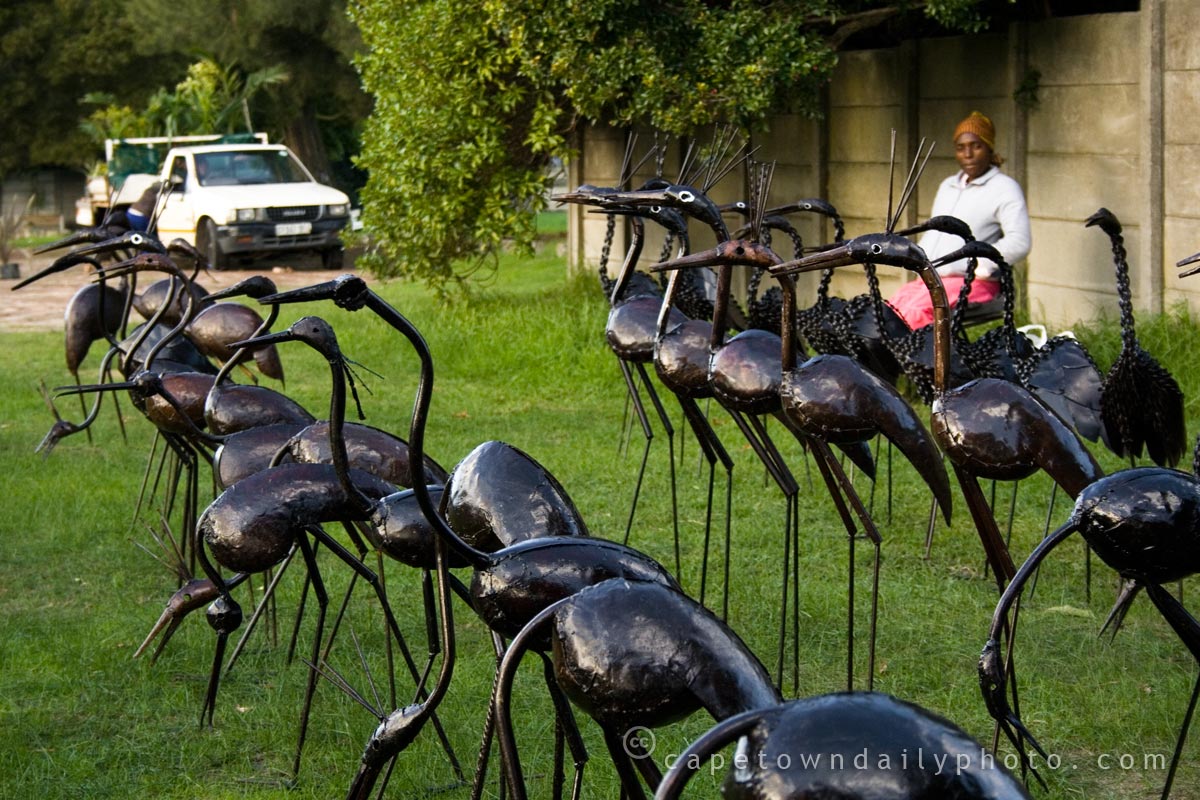
I found out that the cost for these (what I'm assuming to be garden statues) ranges from R180 for the large, more detailed birds at the back, to R150 for the large, but less detailed ones in the second-last row. The price decreases along with the size of the bird, all the way down to R50 for ones about the size of a shoe-box.
As with the tyre-swings, you'll find this stand just up the road from the Stodels Nursery in Bellville.

I've never been much into fish (as pets, I mean - I'm quite fond of a nice piece of seared tuna :P ). I prefer my pets to have fur, generally. But koi fish seem to have become very popular in South Africa - according to the people at Happy Koi, we have the ideal climate for keeping them.
Probably because I've never been much into fish, I didn't actually know that koi are simply a domesticated version of the common carp. I also didn't know that goldfish are a domesticated version of the Prussian carp. I suppose everyone else knew this, though, right?
This particular koi pond is located at Lovane Boutique Wine Estate, which was the subject of yesterday's post.
For official information about COVID-19 from the Department of Health, please visit https://sacoronavirus.co.za